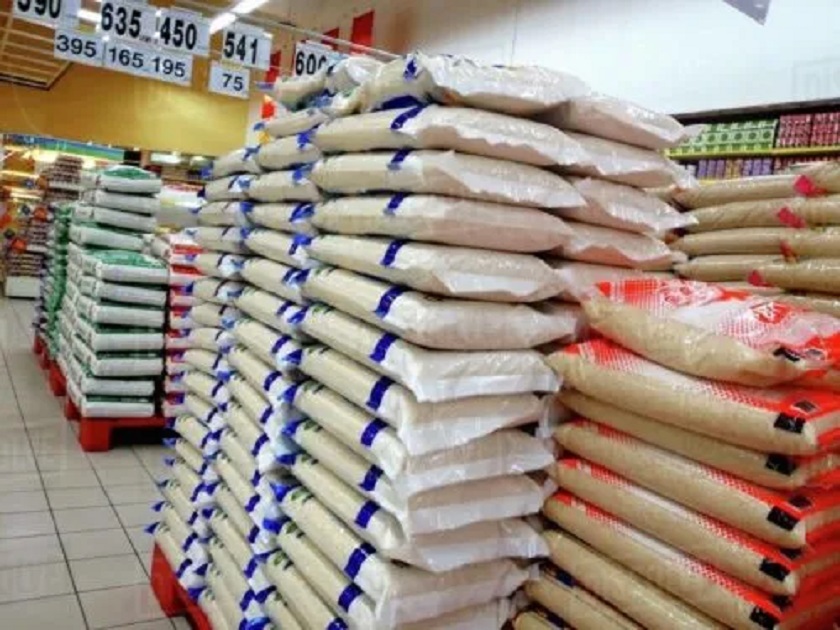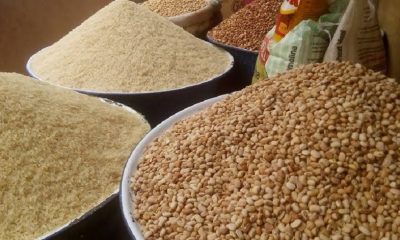Economy
Nigerians to Expect Increase in Prices of Rice in December—Olam

By Adedapo Adesanya
Tough times are on the horizon as one of the nation’s largest rice farms operated by Olam Nigeria has been affected by flooding in Nasarawa State.
Speaking on a programme on Arise TV, Mr Ade Adefeko, the vice-president of Olam Nigeria Limited, said the incident affected the company’s $20 million investment and about 25 per cent of Nigeria’s rice needs.
He said the situation would spike the prices of the commodity at the end of the year. Currently, a 50kg bag of rice sells between N37,000 and N39,000, depending on the brand.
“Well, what happened on October 2, I will tell you that 25 per cent of the crop for rice has been taken out. We should expect an increase in the prices of rice in December. Of course, that goes without saying because the entire crop has been lost,” he said.
Mr Adefeko described the situation as “very terrible”, adding that climate change is real despite all efforts put in place to prevent the damage.
“The entire team from the farm worked very hard to prevent the colossal damage that arose there from the dam broke the likes of the dam the dikes of the farm, and that affected us to a large extent we supply about 25 per cent of Nigeria’s rice needs, and that has been affected and have lost over $20 million,” he said.
The Olam deputy head said the farms were insured, but the damage scale was large.
“Of course, we are insured, But you can insure crops; you cannot replace crops. So, the crop has been insured, but you cannot be replaced. So you have to grow again. So, we are talking about 4400 hectares of farmland gone submerged due to climate change. So it’s very serious.
“Well, like I spoke to the fact that climate change is real. There’s not much you can do about the fact that climate change is real. We’ll continue to do what we have to do. I think NiMET had warned about the impending floods, I am sure you will notice what happened in Kogi as well.
“When they say it rains. It’s not really raining, it’s pouring. So it’s terrible.”
According to Mr Adefeko, Olam farm, located in Rukubi Doma LGA of Nasarawa state, was flooded after River Benue burst its banks and broke the dyke.
“Doma, where we are, is where we have the largest facility. We have the largest rice farm and mill on the continent. It is a $140 million investment, the national $20 million investment, which brought everything to $160 million.
“On our journey to the communities where we operate, it’s terrible. I mean, you need to come and see what is happening. We have over 57 kilometres of dikes surrounding the farms. The farm was built 12 kilometres by 7 kilometres, and 57 kilometres of dikes were meant to stop the flow from entering, but this was made after the 2012 major crisis.”
In another interview with Channels TV, the farm’s Chief Agronomist, Dr Umar Ismaila, said the incident will affect Nigeria’s food security.
The Flood Situation in Nigeria
Many parts of the country have witnessed heavy flooding in recent weeks, with Kogi, Nassarawa, Gombe, and Anambra affected badly. Human and material losses have risen as a result of the unusual rainfalls and the release of excess water from the Lagdo Dam in neighbouring Cameroon’s northern region.
The Nigeria Hydrological Services (NIHSA) blamed state and local governments for disregarding “adequate and timely warnings” and weather advisories issued by various Federal Government agencies.
In August, the Nigerian Meteorological Agency (NEMA) predicted that the prevailing weather pattern in Nigeria would cause above-normal rainfall in about 19 states between August and October this year.
It stated that above-normal rainfall conditions were expected over the northern states such as Sokoto, Zamfara, Katsina, Kano, Jigawa, Yobe, Borno, Bauchi, much of Kebbi and Gombe, as well as northern Kaduna and Adamawa states, whereas normal to above-normal rainfall conditions were expected over most parts of the south-western states including Lagos, Ogun, Osun, much of Oyo, Ondo, parts of Ekiti, and Edo.
It advised states to intensify adaptation, mitigation, and response mechanisms to curb the impending danger
Economy
LCCI Raises Eyebrow Over N15.52trn Debt Servicing Plan in 2026 Budget

By Adedapo Adesanya
The Lagos Chamber of Commerce and Industry (LCCI) has noted that the N15.52 trillion allocation to debt servicing in the 2026 budget remains a significant fiscal burden.
LCCI Director-General, Mrs Chinyere Almona, said this on Tuesday in Lagos via a statement in reaction to the nation’s 2026 budget of N58.18 trillion, hinging the success of the 2026 budget on execution discipline, capital efficiency, and sustained support for productive sectors.
She noted that the budget was a timely shift from macroeconomic stabilisation to growth acceleration, reflecting growing confidence in the economy.
She lauded its emphasis on production-oriented spending, with capital expenditure of N26.08 trillion, representing 45 per cent of total outlays, and significantly outweighing non-debt recurrent expenditure of N15.25 trillion.
According to Mrs Almona, this composition supports infrastructure development, industrial expansion, and productivity growth.
However, she explained that the N15.52 trillion allocation to debt servicing underscored the need for stricter borrowing discipline, enhanced revenue efficiency, and expanded public-private partnerships to safeguard investments that promote growth.
She added that a further review of the 2026 budget revealed relatively optimistic macroeconomic assumptions that may pose fiscal risks.
“The oil price benchmark of $64.85 per barrel, although lower than the $75.00 benchmark in the 2025 budget, appears optimistic when compared with the 2025 average price of about $69.60 per barrel and current prices around $60 per barrel.
“This raises downside risks to oil revenue, especially since 35.6 per cent of the total projected revenue is expected to come from oil receipts.
“Similarly, the oil production benchmark of 1.84 million barrels per day is significantly higher than the current level of approximately 1.49 million barrels per day.
“Achieving this may be challenging without substantial improvements in security, infrastructure integrity, and sector investment,” she said.
Mrs Almona said the exchange rate assumption of N1,512 to the Dollar, compared with N1,500 in the 2025 budget and about N1,446 per Dollar at the end of November, suggests expectations of a mild depreciation.
She said while this may support Naira-denominated revenue, it also increases the cost of imports, debt servicing, and inflation management, with broader macroeconomic implications.
The LCCI DG added that the inflation projection of 16.5 per cent in 2026, up from 15.8 per cent in the 2025 budget and a current rate of about 14.45 per cent, appeared optimistic, particularly in a pre-election year.
She also expressed concern about Nigeria’s historically weak budget implementation capacity, likely to be further strained by the combined operation of multiple budget cycles within a single year.
Looking ahead, Mrs Almona identified agriculture and agro-processing, manufacturing, infrastructure, energy, and human capital development as key drivers of growth in 2026.
She said that unlocking these sectors would require decisive execution—scaling irrigation and agro-value chains, reducing power and logistics costs for manufacturers, and aligning education and skills development with private-sector needs.
The LCCI head stressed the need to resolve issues surrounding the Naira for crude, increase the supply of oil to local refineries to boost local refining capacity and conserve the substantial foreign exchange used for fuel imports.
“Overall, the 2026 Budget presents a credible opportunity for Nigeria to transition from recovery to expansion.
“Its success will depend less on the size of allocations and more on execution discipline, capital efficiency, and sustained support for productive sectors.
Economy
Customs Street Chalks up 0.12% on Santa Claus Rally

By Dipo Olowookere
The Nigerian Exchange (NGX) Limited witnessed Santa Claus rally on Wednesday after it closed higher by 0.12 per cent.
Strong demand for Nigerian stocks lifted the All-Share Index (ASI) by 185.70 points during the pre-Christmas trading session to 153,539.83 points from 153,354.13 points.
In the same vein, the market capitalisation expanded at midweek by N118 billion to N97.890 trillion from the preceding day’s N97.772 trillion.
Investor sentiment on Customs Street remained bullish after closing with 36 appreciating equities and 22 depreciating equities, indicating a positive market breadth index.
Guinness Nigeria chalked up 9.98 per cent to trade at N318.60, Austin Laz improved by 9.97 per cent to N3.20, International Breweries expanded by 9.85 per cent to N14.50, Transcorp Hotels rose by 9.83 per cent to N170.90, and Aluminium Extrusion grew by 9.73 per cent to N16.35.
On the flip side, Legend Internet lost 9.26 per cent to close at N4.90, AXA Mansard shrank by 7.14 per cent to N13.00, Jaiz Bank declined by 5.45 per cent to N4.51, MTN Nigeria weakened by 5.21 per cent to N504.00, and NEM Insurance crashed by 4.74 per cent to N24.10.
Yesterday, a total of 1.8 billion shares valued at N30.1 billion exchanged hands in 19,372 deals versus the 677.4 billion shares worth N20.8 billion traded in 27,589 deals in the previous session, implying a slump in the number of deals by 29.78 per cent, and a surge in the trading volume and value by 165.72 per cent and 44.71 per cent apiece.
Abbey Mortgage Bank was the most active equity for the day after it sold 1.1 billion units worth N7.1 billion, Sterling Holdings traded 127.1 million units valued at N895.9 million, Custodian Investment exchanged 115.0 million units for N4.5 billion, First Holdco transacted 40.9 million units valued at N2.2 billion, and Access Holdings traded 38.2 million units worth N783.3 million.
Economy
Yuletide: Rite Foods Reiterates Commitment to Quality, Innovation

By Adedapo Adesanya
Nigerian food and beverage company, Rite Foods Limited, has extended warm Yuletide greetings to Nigerians as families and communities worldwide come together to celebrate the Christmas season and usher in a new year filled with hope and renewed possibilities.
In a statement, Rite Foods encouraged consumers to savour these special occasions with its wide range of quality brands, including the 13 variants of Bigi Carbonated Soft Drinks, premium Bigi Table Water, Sosa Fruit Drink in its refreshing flavours, the Fearless Energy Drink, and its tasty sausage rolls — all produced in a world-class facility with modern technology and global best practices.
Speaking on the season, the Managing Director of Rite Foods Limited, Mr Seleem Adegunwa, said the company remains deeply committed to enriching the lives of consumers beyond refreshment. According to him, the Yuletide period underscores the values of generosity, unity, and gratitude, which resonate strongly with the company’s philosophy.
“Christmas is a season that reminds us of the importance of giving, togetherness, and gratitude. At Rite Foods, we are thankful for the continued trust of Nigerians in our brands. This season strengthens our resolve to consistently deliver quality products that bring joy to everyday moments while contributing positively to society,” Mr Adegunwa stated.
He noted that the company’s steady progress in brand acceptance, operational excellence, and responsible business practices reflects a culture of continuous improvement, innovation, and responsiveness to consumer needs. These efforts, he said, have further strengthened Rite Foods’ position as a proudly Nigerian brand with growing relevance and impact across the country.
Mr Adegunwa reaffirmed that Rite Foods will continue to invest in research and development, efficient production processes, and initiatives that support communities, while maintaining quality standards across its product portfolio.
“As the year comes to a close, Rite Foods Limited wishes Nigerians a joyful Christmas celebration and a prosperous New Year filled with peace, progress, and shared success.”
-

 Feature/OPED6 years ago
Feature/OPED6 years agoDavos was Different this year
-
Travel/Tourism9 years ago
Lagos Seals Western Lodge Hotel In Ikorodu
-

 Showbiz3 years ago
Showbiz3 years agoEstranged Lover Releases Videos of Empress Njamah Bathing
-

 Banking8 years ago
Banking8 years agoSort Codes of GTBank Branches in Nigeria
-

 Economy3 years ago
Economy3 years agoSubsidy Removal: CNG at N130 Per Litre Cheaper Than Petrol—IPMAN
-

 Banking3 years ago
Banking3 years agoFirst Bank Announces Planned Downtime
-

 Banking3 years ago
Banking3 years agoSort Codes of UBA Branches in Nigeria
-

 Sports3 years ago
Sports3 years agoHighest Paid Nigerian Footballer – How Much Do Nigerian Footballers Earn




















